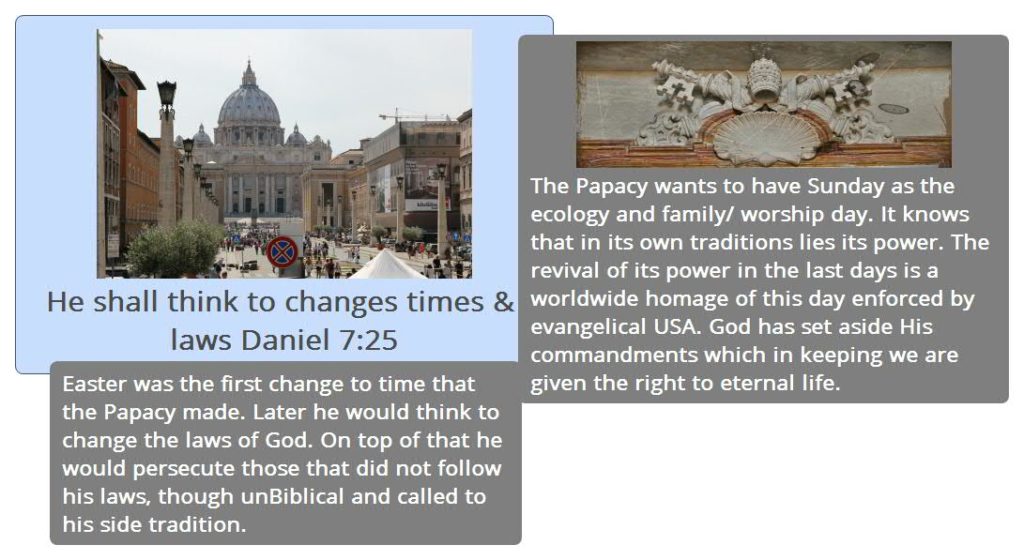The secret to vatican power is in changing times & laws. In history this began with easter. Daniel 7:25
Francis Plotting “Nicea III”
Candida Moss
thedailybeast.com
“After all the speculation surrounding Pope Francis’s ability to engineer peace on his big Middle East trip, the biggest news from the visit came from his visit with Patriarch Bartholomew I, the primary leader of the Eastern Orthodox Church. Not to gloat, but we totally called it.
Following the meeting, Bartholomew gave an interview in which he said that he and Francis are planning a gathering in 2025 in Nicea. The purpose of this meeting? ‘To celebrate together, after 17 centuries, the first truly ecumenical synod.’ That’s right: another historic meeting in Nicea, the place known as the birthplace of Christianity as we know it today.As every media outlet on the planet reminded us, the original Council of Nicea was held in 325 C.E. in modern-day Iznik, Turkey.”
————————————————————————————————
Vatican cardinal supports common Easter date for Catholics, Orthodox
March 12, 2021 CNA Daily News News Briefs 0Print
Cardinal Kurt Koch, president of the Pontifical Council for Promoting Christian Unity, in Rome on Oct. 23, 2019. / Credit: Daniel Ibáñez/CNA.
Vatican City, Mar 12, 2021 / 05:00 am (CNA).- The president of the Pontifical Council for Christian Unity, Cardinal Kurt Koch, has supported a suggestion that Catholics and Orthodox work to agree on a common date to celebrate Easter.
A representative of the Patriarchate of Constantinople to the World Council of Churches (WCC) said a common Easter date could be a sign of “encouragement” for the ecumenical movement.
Orthodox Archbishop Job Getcha of Telmessos suggested that the year 2025, which will be the 1,700th anniversary of the First Ecumenical Council of Nicea, would be a good year to introduce this reform of the calendar.
Speaking with the Swiss news agency Kath.ch, Cardinal Kurt Koch welcomed the proposal, saying the anniversary of the Council of Nicea was “a good opportunity” for this change.
The First Council of Nicea, held in 325, decided that Easter would be celebrated on the first Sunday after the full moon following the beginning of spring, making the earliest possible date for Easter March 22 and the latest possible April 25.
Today, Orthodox Christians use the Julian calendar to calculate the Easter date instead of the Gregorian calendar, which was introduced in 1582 and is used by most of the world. Because the Julian calendar calculates a slightly longer year, it is currently 13 days behind the Gregorian calendar.
Cardinal Koch said “I therefore welcome the move by Archbishop Job von Telmessos” and “I hope that it will meet with a positive response.”
“It will not be easy to agree on a common Easter date, but it is worth working for it,” he stated. “This wish is also very dear to Pope Francis and also to the Coptic Pope Tawadros.”
Getcha noted that as early as 1997 a consultation was held by the WCC to discuss a common Easter date for Catholics and Orthodox. At that time it was decided to keep the norms established by the Council of Nicea.
If you value the news and views Catholic World Report provides, please consider donating to support our efforts. Your contribution will help us continue to make CWR available to all readers worldwide for free, without a subscription. Thank you for your generosity!
“God had ordained that the Passover of the Old Testament should be celebrated in the spring of the year on the fourteenth day of the first Bible
month. Heathenism in the centuries before Christ had a counterfeit yearly holiday celebrating the spring equinox of the sun. It was called “Eostre” from the Scandinavian word for the goddess of spring, from which we get our word “Easter.” Since the resurrection of Christ had occurred at the time of the Old Testament Passover, a custom developed of celebrating it yearly, though neither Christ nor the New  Testament provided for it. This rivaled the pagan spring festival. However, the fourteenth day of the month of the Passover could fall, as now, on any day of the week. The eastern churches celebrated the resurrection of Christ annually two days after the Passover feast. They commemorated the resurrection on whatever day of the week the sixteenth day of the month fell. This was in harmony with the way the Bible regulated the Old Testament Passover feast. In addition to their yearly spring festival at Eastertime, sun worshipers also had a weekly festival holiday. As was previously pointed out, the first day of the week had widespread recognition as being sacred to the sun. The bishop of Rome, seeking to outrival pagan pomp, assaulted those churches which celebrated Easter as a movable feast. He determined to force Easter to come on the same day of the week each year, namely, Sunday.” Truth Triumphant B J Wilkinson
Testament provided for it. This rivaled the pagan spring festival. However, the fourteenth day of the month of the Passover could fall, as now, on any day of the week. The eastern churches celebrated the resurrection of Christ annually two days after the Passover feast. They commemorated the resurrection on whatever day of the week the sixteenth day of the month fell. This was in harmony with the way the Bible regulated the Old Testament Passover feast. In addition to their yearly spring festival at Eastertime, sun worshipers also had a weekly festival holiday. As was previously pointed out, the first day of the week had widespread recognition as being sacred to the sun. The bishop of Rome, seeking to outrival pagan pomp, assaulted those churches which celebrated Easter as a movable feast. He determined to force Easter to come on the same day of the week each year, namely, Sunday.” Truth Triumphant B J Wilkinson